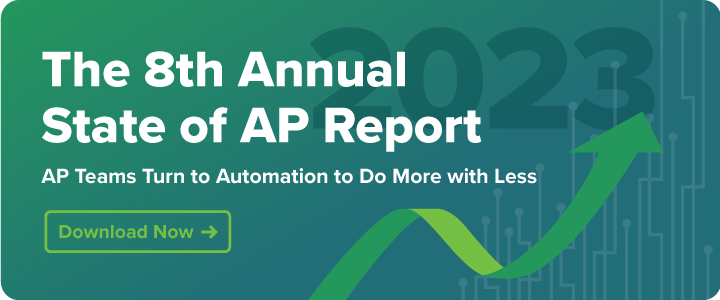For accounts payable (AP) teams, vendor payments are the cornerstone of business relationships. Timely, accurate, and convenient payments are not just transactions — they’re the foundation of trust and partnership.
In addition to meeting supplier expectations, choosing the right payment method can significantly improve the finance department’s efficiency and productivity. In fact, 60% of finance leaders say ease of use is the main driver for their organization’s supplier payment method. Moreover, certain payment methods offer greater security than others. This becomes even more important as the threat landscape evolves and instances of fraud continue to rise.
This blog will dive into the key differences between some of today’s most prevalent options for business payments: ACH vs. virtual cards vs checks. By understanding the security, visibility, costs, and processes associated with each, finance departments can make more informed decisions and bolster vendor relationships.

An Overview of Various Payment Methods
Organizations have more options than ever regarding payment methods. ACH payments, virtual card payments, and payments using traditional checks are the most common:
ACH
ACH payments enable organizations to securely move money from one bank to another through the ACH Network. Governed by the National Automated Clearing House Association (NACHA), these payments can facilitate direct deposits, direct payments, and electronic checks. The streamlined process eliminates the need for paper checks and the associated manual processes.
Checks
Checks are a traditional method of payment that requires organizations to issue physical documents, which recipients must then manually sign and deposit. While checks are a familiar option, they present risks like fraud exposure and the potential for mail delays.
Virtual Cards
Virtual cards work similarly to credit cards, providing a secure and efficient payment method. Unlike credit cards, they use randomly generated tokenized numbers, which eliminates the need for businesses to expose their payment credentials every time they make a transaction. Businesses typically use virtual cards for a single transaction, which enhances payment security and control.
4 Key Differences
Nearly three-quarters (71%) of finance leaders say their organization will convert more of its AP spending to electronic payment methods next year. Electronic payments enable greater security, ease of use, and cost savings. But regarding ACH vs. checks vs. virtual cards, you must consider security, visibility, cost, and process. This research helps you identify a payment method that meets the needs of you and your suppliers. Let’s take a closer look:
1. Security and Risk of Fraud
Of these payment methods, checks are the most vulnerable to fraud. In fact, 63% of survey respondents noted that they dealt with fraud activity via checks. The physical nature of checks makes them susceptible to unauthorized duplication or alteration and human error.
Virtual cards offer increased security by using tokenized numbers. Tokenization replaces sensitive card data with a random string of characters, making the information useless if it falls into the wrong hands. Additionally, virtual cards are typically only charged once for a specified amount, reducing the risk of fraud. According to the same survey, only 9% of organizations said their virtual cards were subject to fraudulent activities in 2022.
While ACH payments are generally more secure than checks, ACH fraud has recently become a major risk for AP teams. Fraudsters use a range of tactics to execute their attacks, including business email compromise (BEC) emails and malware. In fact, 30% of organizations reported fraudulent activity in relation to their ACH payments.
2. Visibility and Late Payments
Speed of payment is the most important aspect of the payment experience for 84% of vendors. With that in mind, it’s important to note that checks can easily get lost in the mail, leading to delays and late payments. On the other hand, ACH and virtual card payments offer real-time tracking and visibility, which reduces the risk of late payments and associated penalties.
Virtual cards make it easy to track invoice payments, increasing visibility throughout the payment process. When you use ACH payments in tandem with an AP automation platform, you can centralize payment information into a single location. This not only helps you track invoice payment status more easily, but also offers your vendors increased visibility.
3. Costs
The cost implications of each payment method vary significantly. Traditional paper checks typically incur processing costs ranging from $5 to $12, accounting for stamps, printing, and labor. The cost of ACH payments typically ranges between $0.26 and $0.50, including software costs and financial institution or payment processing fees.
Notably, virtual cards can transform expenses into profits. While virtual cards may necessitate minor processing fees, businesses have earned up to $100,000 in rebates using virtual cards.
4. The Process
Without an AP automation solution, check runs involve manual processes that are difficult to complete among a hybrid workforce. From a productivity standpoint alone, finance teams often find traditional checks too demanding due to the manual steps involved.
ACH payments involve a streamlined process in establishing a connection between your accounting system and a bank. This integration facilitates the electronic transfer of funds between accounts, offering a seamless and efficient method for secure transactions. Another option is to set up ACH transactions in an AP platform like MineralTree, that also handles vendor onboarding and management.
The process associated with virtual card payments generates unique, one-time-use card numbers linked to specific transactions. This approach facilitates seamless interactions with vendors, offering a more efficient and controlled method for handling payments in the AP process. Additionally, AP automation solutions like MineralTree can help accounts payable teams enroll vendors into virtual card programs.
| Checks | ACH | Virtual Cards | |
|---|---|---|---|
| Security | Vulnerable to fraud | Secure with the right controls in place | Secure |
| Visibility and Late Payments | Prone to delays and loss in the mail | Real-time tracking | Real-time tracking |
| Costs | $5 to $12 (processing, printing and stamps) | $0.26 to $0.50 | Potential for rebates and profits |
| Process | Manual, time-consuming | Paperless, streamlined, automated | Paperless, streamlined |
Final Thoughts
As you navigate the complex world of business payments, it’s crucial to select a payment method that offers the level of security, reliability, and cost-effectiveness your finance department needs. MineralTree accommodates diverse preferences, allowing you to pay vendors in your preferred format — whether it be ACH, checks, or virtual cards — without additional workflows. MineralTree’s automated solution eliminates the need for manual processes, liberating your AP team from traditional check run hassles.
Get in touch to learn how MineralTree can enhance your B2B transactions and streamline your AP processes.

Frequently Asked Questions
What are the benefits of ACH payments over checks?
ACH payments offer enhanced security, real-time tracking, and cost-effectiveness compared to traditional checks. The reduced risk of fraud and streamlined payment process make ACH a preferred choice for most modern businesses.
What are the advantages of virtual cards over checks?
Virtual cards provide a more secure and efficient payment method than traditional checks, minimizing the risk of fraud and late payments. Checks increase the risk of fraud and mail delays, resulting in late payments and associated fines. Additionally, businesses can capitalize on rebates and turn payment expenses into profits with virtual cards.
What is the difference between ACH and electronic checks?
While both involve electronic transactions, ACH payments typically refer to bank-to-bank transfers, while electronic checks can be digital versions of traditional paper checks. ACH transactions often offer faster processing times.
What is the risk of paying with ACH?
While ACH payments are generally secure, businesses should be vigilant against potential fraud. Implementing robust security measures can mitigate the risk of ACH fraud. Additionally, using an accounts payable (AP) automation solution eliminates the need for human intervention, further minimizing fraud risks.



